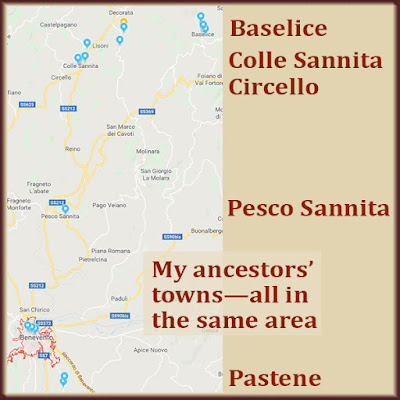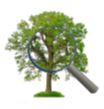I'm mapping out a strategy to discover how my parents are distant cousins, as our DNA tells us.
An analysis of my raw DNA on GEDmatch.com shows that my parents are "probably distantly related." Their Ancestry DNA results predict that they are 4th–6th cousins. That should mean they share a set of 5th–7th great grandparents.
I want to find that link between mom and dad's DNA.
But there's another piece to this puzzle. My mom's sister's son (my first cousin Nick) is a DNA match for my dad. Ancestry DNA estimates my cousin and my dad are 5th–8th cousins. Nick's related to both my mom and my dad.
My mission is clear: Find the set of ancestors that my parents share…and see if they're the same ancestors my dad and my cousin share!
 |
| Plotting out where my ancestors lived, they were all pretty close together. |
My method is less clear. So let's work through the logic.
My dad's side of the family comes the Benevento province (similar to a U.S. county). My mother's side comes from the same province. What if, at some point, a man from one of dad's towns married a woman from one of mom's towns?
For at least several hundred years, all my ancestors lived no more than 25 or 30 miles apart. Many lived 5 or 10 miles apart, but that's as the crow flies. I've visited these rural, hill towns. They're separated by windy, hard-to-navigate, and sometimes washed-out roads.
My husband and I spent nearly an hour trying to get from one town (Colle Sannita) to the neighboring town (Baselice). We thought we'd never make it.
That experience got me thinking about how hard it was for my ancestors to go from town to town on a mule-drawn cart. That's why it's more logical to look at towns that were closer to one another.
I have 2 main choices. I can concentrate on my 2 grandfathers' towns, the ones that are a nightmare drive apart. Or I can take a hard look at 2 towns that are much closer together.
Colle Sannita (Grandpa Iamarino's town) neighbors the town of Circello. They're very close to one another, and the roads don't have to switch back and forth over mountains. Much easier on a mule cart.
 |
| One set of my 3rd great grandparents had an inter-town marriage. |
I've known for years that my cousin Nick's dad's family came from Circello. (Remember, Nick is my cousin on our mothers' sides.) But I found out recently that my 3rd great grandfather was born in Circello.
Francesco Saverio Liguori was born in Circello in 1813. In 1840 he married Anna Donata Cerrone in Colle Sannita, settled there and raised his family.
So my dad has some roots in Circello. When you look at these 2 facts:
- Nick's last name comes from Circello
- my dad's DNA match list has at least 3 people with that name
…it seems as if that last name may connect my cousin to my dad. But will it connect my mom to my dad? That's the big goal.
Is Nick a DNA match to my dad because of his own last name? Or is the connection through his mom, who is the same distant cousin of my dad as her sister—my mom?
Here's the plan I'm going to follow, and hope it leads to identifying that DNA connection.
- I'll work to build out Nick's Circello branch of the family tree.
- I'll also work to build out his grandmother's family tree. Why? Because she was from my Grandpa Iamarino's town! His grandparents had exactly the type of inter-town marriage I need to explore.
- I'll study my grandparent chart and look for last names that don't seem native to their town. For example, my 4th great grandmother's last name (Tricarico) isn't one I've seen in the town where she lived. Maybe her parents or grandparents came from another town. And maybe, just maybe, her ancestors will tie my mom and dad together.
I've spent so much time living among my ancestors' vital records collections, I can spot an uncommon name in a given town. Liguori, my 3rd great grandfather's last name, was out of place. And that turned out to be entirely true.
It's important to get really familiar with last names in your ancestors' towns. Maybe you can learn the main names in your ancestor's town by looking at land records. Or by paying attention to all the names on the index pages when searching for your ancestor's birth record.
Wish me good luck. I'll report back when I think I've found that missing link!















